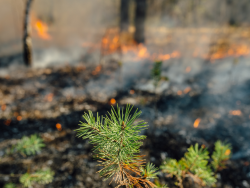
Even before the devastating wildfires in recent years, homeowners in many Western states have generally understood the concept of defensible space and brush clearance to keep their homes away from dangerous, unmanaged wild vegetation. However, it may surprise many homeowners that their landscape vegetation could also pose similar, or sometimes even greater, dangers.
While it may seem counterintuitive to think that visually appealing landscape vegetation could be potential fire hazards, there are two basic facts that make this seem perfectly probable. First, all landscape vegetation can ignite under the right conditions – even the most lush and green plants can become fuel for wildfires. Second, landscape vegetation by design tends to be located near and around the house, therefore, once landscape vegetation ignites, their close proximity greatly increases the fire risk to the house.
To enjoy the many benefits that beautiful landscape vegetation can provide homeowners, and simultaneously, reduce potential wildfire hazards, consider these three important P’s for landscape vegetation:
- Plants: Carefully choose plants with wildfire-friendly characteristics. Choose fire-resistant plants with less waxes, oils, and resins. Make sure the plants are native to the local environment, are drought tolerant, and are low maintenance with limited shedding and debris.
- Proximity: Strategically locate plants in relation to the house and to other plants. Minimize or eliminate plants that are within 5 feet of the house perimeter, and keep plants spaced out in clusters or islands to reduce continuous fire spread. Also, provide adequate space between trees to minimize fire transfer from one tree to the other.
- Prune: Regularly prune and trim plants to maintain fire resistance. This consists of removing dead branches, foliage, debris and keeping vines from growing on the house. Make sure to trim tree branches overhanging the roof by at least 10 feet and limb them up at least 8 feet off the ground.
With spring planting season approaching and the inevitable wildfire season to follow, homeowners should begin to assess the condition of their landscape vegetation as part of their overall wildfire preparedness strategy.
For additional information on this topic, there are many resources homeowners can access including their insurance company, fire department, as well as the National Fire Protection Association (NFPA) and the American Society of Landscape Architects (ASLA).
Joe Kim is an Assistant Vice President and Premier Account Specialist at Chubb Personal Risk Services.
The opinions and positions expressed are the authors’ own and not those of Chubb. The information and/ or data provided herein is for informational purposes only and is not a substitute for professional advice. Insurance coverage is subject to the language of the policies as issued.